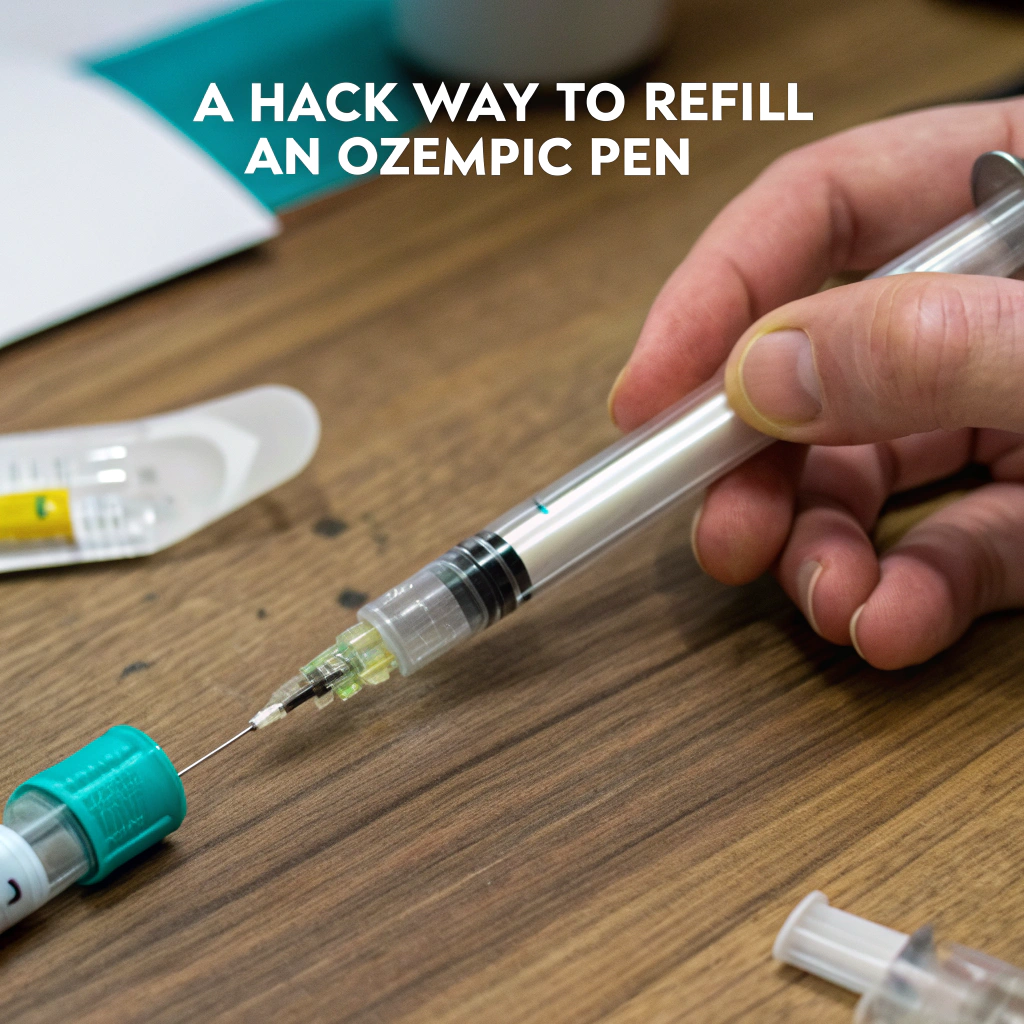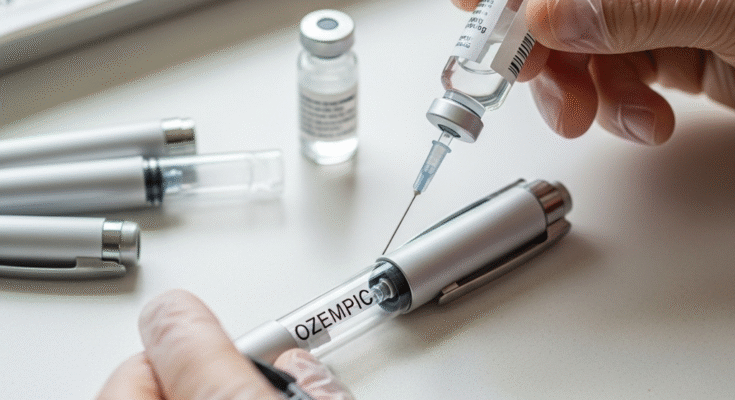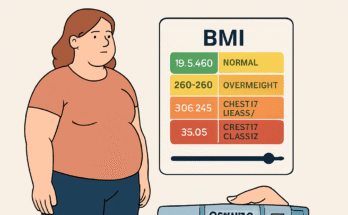Ozempic, a brand-name GLP-1 receptor agonist pen containing semaglutide, has transformed type 2 diabetes medication costs and weight loss medication pens for millions of patients. As these prefilled pen injection devices come with a significant price tag, many users wonder: can you refill Ozempic pens at home? The short answer is no, and understanding why is crucial for your safety and treatment success.
How Ozempic Pens Are Designed: The Engineering Behind Safety
The Ozempic pen mechanism explained reveals sophisticated engineering designed specifically for single-use purposes. These prefilled pen injection devices are manufactured as closed systems that cannot be safely reopened or refilled. Each pen contains precisely measured doses of semaglutide injection in a sterile environment, sealed during manufacturing to prevent contamination.
Novo Nordisk Ozempic official guidelines explicitly state that these pens are disposable devices. The internal mechanism includes a dosing dial, delivery system, and cartridge that work together as an integrated unit. Unlike reusable insulin pen syringes that accept replaceable cartridges, Ozempic pens lack the structural design for refilling. The medication pen needle replacement process only involves changing the external needle, not accessing the internal medication reservoir.
Why You Shouldn’t Refill Ozempic Pens: Critical Safety Concerns
Contamination Risks Refilling Medication Pens
The primary danger of attempting DIY insulin pen refill dangers involves sterile injection practices home use. When you breach the pen’s sealed system, you introduce potential contaminants including:
- Bacterial contamination: Opening the pen exposes the medication to airborne bacteria, which can multiply rapidly in the solution
- Particulate matter: Dust, fibers, and other particles can enter the medication, potentially causing injection site reactions or blocking the delivery mechanism
- Chemical degradation: Semaglutide is sensitive to environmental conditions; exposure to air and light can reduce its effectiveness
Reusing Single-Use Medication Pens Risks

The FDA Ozempic pen safety information clearly outlines that these devices are engineered for single-use. Attempting to refill them poses several medical risks:
- Inaccurate dosing: The pen’s internal mechanism calculates remaining doses based on its original fill. Refilling disrupts this calibration, potentially leading to underdosing or overdosing.
- Cross-contamination: Even with careful handling, introducing new medication into a used cartridge can contaminate both the new and remaining medication.
- Mechanical failure: The pen’s delivery system is designed for a specific number of doses. Forcing additional medication can damage the internal components, resulting in Ozempic pen not working after dose attempts.
- Loss of sterility: Pharmaceutical-grade sterility cannot be maintained in home environments, regardless of precautions taken.
What Happens When Ozempic Pen Is Empty: Proper Protocol
When your Ozempic pen runs out, following proper Ozempic pen disposal guidelines is essential. Most pens contain a small amount of medication that remains after the last full dose—this is by design and does not indicate malfunction.
The correct procedure when your pen is depleted:
- Remove and safely dispose of the needle in a sharps container
- Replace the pen cap
- Dispose of the entire pen according to local regulations for medical waste
- Never attempt to extract the remaining medication visible in the pen window
- Start a new pen with a fresh, sterile needle
Ozempic Pen Troubleshooting Guide: Common Issues
Is It Safe to Refill Diabetes Medication Pens?
This question frequently arises in diabetes communities, but the answer remains firmly negative for Ozempic. While some older reusable insulin pens accept replacement cartridges, Ozempic pens are fundamentally different. The semaglutide vials vs pens debate sometimes confuses patients into thinking pen refilling is possible, but vials are only compatible with standard syringes, not with pen devices.
Ozempic Pen Refill Instructions: The Truth
Despite online searches for “how to refill Ozempic pen safely,” no legitimate medical source provides such instructions because safe refilling is impossible. Any purported Ozempic pen refill instructions found online promote dangerous practices that violate:
- Manufacturer guidelines
- FDA regulations
- Medical safety standards
- Subcutaneous injection safety protocols
Cost-Saving Alternatives to Refilling Ozempic
Understanding that medication waste reduction strategies are important, let’s explore legitimate ways to manage type 2 diabetes medication costs:
Patient Assistance Programs for Expensive Diabetes Medications
Ozempic Patient Assistance Program: Novo Nordisk offers support for eligible patients who cannot afford their medication. Visit their official patient support resources to determine eligibility.
Ozempic Coupon Savings Card: Commercially insured patients may qualify for savings cards that significantly reduce out-of-pocket costs. These programs can lower monthly expenses to as little as $25.
Where to Buy Ozempic Cheaper: Legitimate Options
- Pharmacy comparison shopping: Prices vary significantly between pharmacies. Use prescription discount programs to compare.
- Buy Ozempic pens online through verified Canadian or international pharmacies with proper credentials (verify CIPA certification).
- Mail-order pharmacy services: Many insurance plans offer reduced costs through 90-day mail-order supplies.
- Ozempic prescription discount programs like GoodRx, SingleCare, or RxSaver can provide substantial savings.
Affordable Ozempic Alternatives Worth Considering
Generic Semaglutide Injection Pens: While true generic Ozempic isn’t yet available in the United States, compounding pharmacy semaglutide offers a lower-cost alternative. These compounded versions contain the same active ingredient but must be obtained through specialized pharmacies.
Tirzepatide vs Semaglutide Pens: Mounjaro (tirzepatide) is another GLP-1 medication that may have different insurance coverage or assistance programs. Discuss with your healthcare provider whether switching could provide cost benefits.
Ozempic Shortage Alternatives: During supply shortages, your doctor might prescribe different GLP-1 medications or adjust your treatment plan.
Proper Ozempic Pen Storage and Handling: Maximizing Your Investment
To ensure you get every prescribed dose from your pen:
Before First Use
- Store unopened pens in the refrigerator (36°F to 46°F)
- Never freeze Ozempic; frozen pens must be discarded
- Protect from light by keeping pens in their original carton
After First Use
- Store at room temperature (up to 86°F) or continue refrigerating
- Use within 56 days of first use
- Keep the pen cap on when not in use
- Avoid exposing the pen to extreme heat or direct sunlight
Semaglutide Injection Technique for Maximum Efficiency
Proper injection technique ensures you receive the full prescribed dose:
- Select injection sites: Rotate between abdomen, thigh, and upper arm
- Prepare the pen: Attach a new needle for each injection (never reuse needles)
- Prime the pen: For new pens, perform a flow check as outlined in the Ozempic manufacturer instructions
- Inject correctly: Insert the needle at a 90-degree angle, press the dose button, and hold for 6 seconds
- Remove safely: Withdraw the needle straight out and dispose of it immediately
What to Do When Ozempic Pen Runs Out Early
If your pen empties before the expected time, several factors might be responsible:
- Priming excess: Over-priming before injections wastes medication
- Leakage: Removing the needle too quickly or not holding the injection button long enough can cause medication loss
- Dosage increase: If you recently increased your dose, your pen will empty sooner
- Defective pen: Rarely, manufacturing defects can cause premature depletion
In these situations, contact Ozempic patient support resources or your pharmacy. Many pens come with manufacturing guarantees for defects.
Understanding Your Ozempic Dosing Schedule
The standard Ozempic dosing schedule progresses as follows:
- Weeks 1-4: 0.25 mg once weekly (this is a starter dose, not a therapeutic dose)
- Weeks 5+: 0.5 mg once weekly
- Optional increase: After at least 4 weeks at 0.5 mg, may increase to 1 mg weekly
- Maximum dose: 2 mg once weekly for additional glycemic control if needed
Each pen size contains specific doses:
- 2 mg pen: Six 0.25 mg doses OR two 0.5 mg doses
- 4 mg pen: Four 0.5 mg doses OR two 1 mg doses
- 8 mg pen: Four 1 mg doses OR two 2 mg doses
Understanding this Ozempic dosing schedule helps you plan refills appropriately and avoid running out unexpectedly.
The Medical and Legal Implications
Attempting to refill or modify medication pens can have serious consequences beyond immediate health risks:
Medical Liability
If you experience adverse effects from modified or refilled pens, manufacturer warranties and insurance coverage may be void. Healthcare providers cannot support unapproved medication modifications.
Medication Integrity
The pharmaceutical industry strictly regulates medication delivery systems. The sterile injection practices for home use cannot replicate manufacturing standards. Even healthcare facilities cannot refill these pens—they’re disposed of and replaced.
Insurance and Prescriptions
Insurance companies base coverage on approved, manufactured products. Using refilled or modified pens could jeopardize coverage and violate prescription guidelines.
Legitimate Medication Waste Reduction Strategies
While refilling isn’t safe, you can minimize waste through proper practices:
Optimize Each Dose
- Master the semaglutide injection technique to prevent leakage
- Wait the full 6 seconds after pressing the dose button
- Don’t over-prime the pen (one flow check per new pen only)
- Store pens correctly to maintain medication potency
Plan Refills Strategically
- Track your doses and schedule refills before running out
- Coordinate with your pharmacy to avoid gaps in treatment
- Request the appropriate pen size for your current dose
Explore Alternative Formulations
Discuss with your healthcare provider whether switching between prefilled pen injection devices and traditional vials with syringes might offer cost benefits. Some patients find that purchasing semaglutide vials with separate syringes reduces overall costs, though this requires comfort with self-injection using traditional syringes.
The Future of GLP-1 Medications and Affordability
The landscape of weight loss medication pens and diabetes treatments continues evolving. Several developments may improve accessibility:
- Generic approvals: Patent expirations will eventually allow generic semaglutide injection pens
- Biosimilar competition: Similar medications from different manufacturers will increase market competition
- Insurance coverage expansion: As these medications prove long-term benefits, coverage is improving
- Compounding availability: Compounding pharmacy semaglutide provides current alternatives, though with some limitations
Making Informed Decisions About Your Treatment
When facing high medication costs, it’s tempting to seek creative solutions like refilling pens. However, the risks far outweigh any potential savings. Instead, focus your energy on:
- Exploring patient assistance: Thoroughly investigate the Ozempic patient assistance program and Ozempic coupon savings card options
- Communicating with providers: Discuss your financial concerns openly with healthcare providers who may know about affordable Ozempic alternatives
- Insurance advocacy: If denied coverage, file appeals and work with your doctor to document medical necessity
- Legitimate discount programs: Use verified Ozempic prescription discount platforms
- Alternative treatments: Explore whether other medications in your insurance formulary might work for your condition
Conclusion: Safety First in Diabetes Management
The question “Can you refill Ozempic pens at home?” stems from understandable frustration with prescription costs. However, the definitive answer—supported by Novo Nordisk Ozempic official guidelines, FDA Ozempic pen safety information, and medical consensus—is that refilling these pens is neither safe nor effective.
The contamination risks refilling medication pens, combined with dosing inaccuracies and mechanical failures, create unacceptable health hazards. DIY insulin pen refill dangers apply equally to semaglutide, regardless of intent or careful handling.
Instead of risking your health with improvised solutions, invest time in accessing legitimate cost-reduction programs. The Ozempic patient support resources, patient assistance programs for expensive diabetes medications, and various discount options can make treatment affordable without compromising safety.
Remember that proper Ozempic pen storage and handling, mastering the semaglutide injection technique, and following Ozempic manufacturer instructions will help you maximize each pen’s value legally and safely. When your pen is empty, follow proper Ozempic pen disposal guidelines and obtain a new one through appropriate channels.
Your health is worth protecting with properly manufactured, sterile medication delivered through devices designed for your safety. No amount of cost savings justifies the risks of reusing single-use medication pens or attempting dangerous workarounds. Work with your healthcare team to find sustainable, safe solutions for managing your diabetes or weight loss journey with this powerful GLP-1 receptor agonist pen.

Lisa Caldwell is a clinical health writer and certified diabetes educator with a strong background in pharmacology and metabolic health. With over 12 years of experience in patient education, she specializes in translating complex research on GLP-1 medications like Ozempic into clear, practical guidance.




